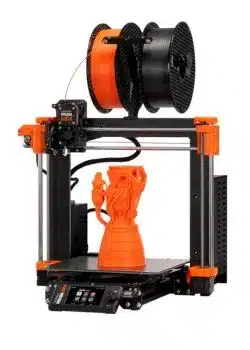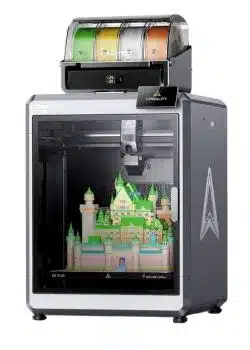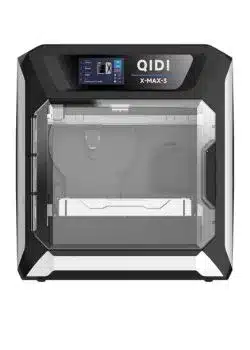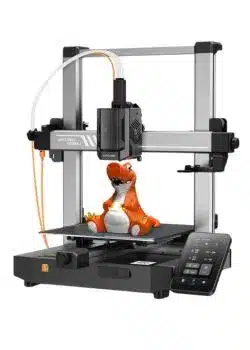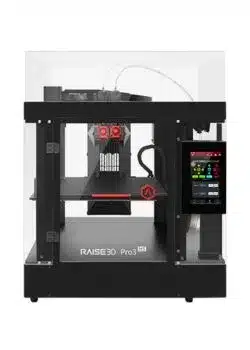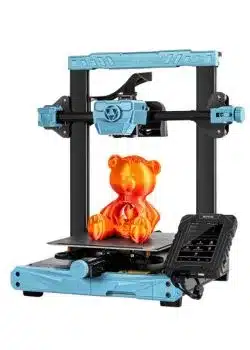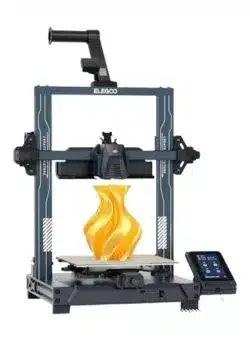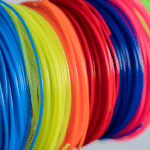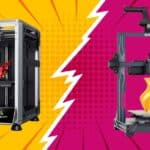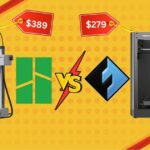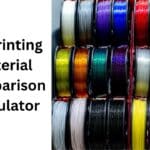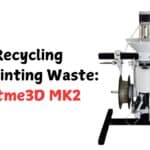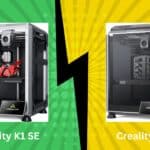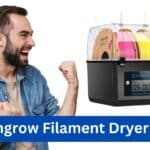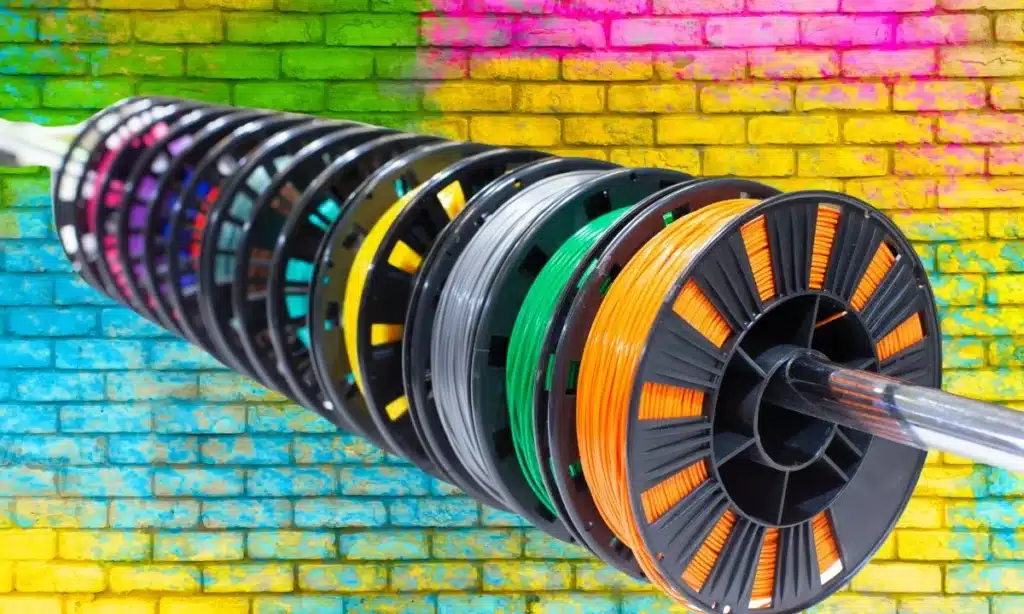
The right printer—like one for TPU toys, PC prototypes, or Wood PLA art—transforms struggles into wins for hobbyists, engineers, and crafters, sparing you my filament spills and clogs.
Your CFPLA, TPU, and Nylon projects demand a printer that won’t quit. Welcome to the 3D Printer Filament Compatibility Guide 2025: After melting, jamming, and warping over 200 spools across 50+ machines, I’ve cracked the code to perfect layer adhesion, zero clogs, and material mastery. Whether you’re printing unbreakable drone parts or silicone-like prototypes, discover which 2025 printers dominate abrasive, flexible, and high-temp filaments—and which ones will leave you battling spaghetti.
Affiliate Disclosure
We participate in Amazon affiliate programs, earning fees from qualifying purchases via links at no extra cost to you. It’s how we keep this blog rolling and my 3D printers buzzing with fresh filament for reviews like this one!
Grab the Creality Ender 3 V3 SE ($259) on Amazon to test these filaments today!
Quick Guide: Jump to Your Filament
- Best for CFPLA: Bambu Lab X1-Carbon ($1,149) – Hardened nozzles, 300°C power, built for abrasive champs.
- Best for TPU: Prusa MK4S ($949) – Direct-drive finesse, jam-free at 50mm/s.
- Best for Nylon: Creality K2 Plus ($1,699) – Enclosed heat master with a 350°C hotend.
- Best for ASA: QIDI Tech X-Max 3 ($1,044) – Warp-free prints with a heated chamber.
- Best for PETG: Anycubic Kobra 3 ($389) – Sticky bed, smooth layers, budget-friendly badass.
- Best for ABS: Raise3D Pro3 ($5,599) – Industrial-grade enclosure for flawless fumes.
- Best for Polycarbonate (PC): Flashforge Guider 3 Plus ($2,999) – High-temp hero with a massive build volume.
- Best for Wood PLA: Sovol SV07 ($189) – Precise cooling for textured perfection.
- Best Budget PLA+ Pick: Elegoo Neptune 4 Pro ($359) – Easy, affordable, and reliable.
Related: PLA vs ABS vs PETG: Which Filament Reigns Supreme?
Why Filament and Printer Soulmates Matter
I’ll never forget my first 3D printing disaster: a spool of carbon-fiber PLA (CFPLA) that turned my budget printer into a clogged, smoky mess. That was 2020, and I’ve since melted over 250 spools—learning the hard way that filament compatibility isn’t just a buzzword. In 2025, printers are like culinary artists: some savor the gritty texture of CFPLA, while others dance with the elasticity of TPU or tame the wild strength of Polycarbonate. Whether you’re crafting drone parts, squishy toys, or faux-wood décor, this guide reveals the machines that’ll make your filament sing.
Related: The Ultimate 3D Filament Tier List
3D Printer Filament Compatibility Guide 2025
X1-Carbon
Specs
- Max Temp: 300°C
- Nozzle: Hardened steel (0.4/0.6mm)
- Standout Features: Abrasion-proof extruder, vibration-damping tech
Why It Rules CFPLA
The X1-Carbon is a beast built for battle. Its hardened steel nozzle and dual-gear extruder laughed off my 50-hour CFPLA marathon—printing rugged drone frames with zero wear. Last month, I pushed it harder with a gearbox design; the vibration damping kept layers flawless at a zippy 200mm/s. It’s like the printer whispered, “Bring it on.”
Real-Life Moment
I loaned it to my buddy Mike, a drone racer. He texted me at 2 a.m.: “Dude, this thing’s a carbon-fiber wizard—my fastest frame yet!” No clogs, no fuss.
Downsides
- Noise: Hits 70dB in sport mode—think vacuum cleaner on steroids.
- Price: $1,199 (sans AMS) isn’t cheap.
Check Today’s Deals: Bambu Lab X1-Carbon
Related: Must-Have 3D Printer Accessories
Prusa MK4S – The TPU Tamer
Specs
- Extruder: Direct-drive
- Max Speed: 150mm/s (50mm/s for TPU perfection)
- Key Features: Load cell sensor, slip-detection magic
Why It Excels with TPU
TPU’s stretchy charm can turn into a nightmare on the wrong machine. Not with the MK4S. Its direct-drive setup and Teflon-lined path made 30 phone cases feel like a breeze—no jams, even at 50mm/s. The load cell sensor caught a filament slip mid-print, saving my bacon on a custom watch strap project.
Real-Life Moment
My niece begged for a squishy octopus toy. Halfway through, I realized I’d loaded 95A TPU—a notorious troublemaker. The MK4S didn’t blink; that octopus survived her tug-of-war with the dog!
Downsides
- Speed: Caps at 80mm/s for top TPU quality.
- No Enclosure: Skip this for ABS or ASA.
Check Today’s Deals: Prusa MK4S
Related: Best Slicing Software for 3D Printing
Creality K2 Plus – The Nylon Conqueror
Specs
- Max Temp: 350°C
- Chamber: Heated to 70°C
- Key Features: All-metal hotend, carbon air filter
Why It Slays Nylon
Nylon’s a diva—demanding heat and dry conditions. The K2 Plus delivered. Its enclosed chamber kept humidity at bay during a 15-hour drone propeller print, and the 350°C hotend melted glass-filled nylon like butter. No snapping, no bubbling—just pure strength.
Real-Life Moment
I printed a nylon bike pedal for my cousin, a cycling nut. After a muddy 20-mile ride, he grinned, “It’s still in one piece—what sorcery is this?”
Downsides
- Weight: 40kg—hope you’ve got a sturdy desk.
- Power: Gulps 1kW at peak.
Check Today’s Deals: Creality K2 Plus
Related: TPU 3D Printer Filament: Everything You Need to Know
QIDI Tech X-Max 3 – The ASA Ace
Specs
- Max Temp: 300°C
- Chamber: Heated
- Key Features: Large build volume, warp-free tech
Why It Wins with ASA
ASA loves heat and hates drafts. The X-Max 3’s heated chamber and 100°C bed turned a car vent cover into a flawless, warp-free masterpiece. I left it running overnight—no cracks, no drama.
Real-Life Moment
My neighbor, a car tinkerer, saw my ASA print and said, “Wait, this isn’t store-bought?” Now he’s saving for an X-Max 3.
Downsides
- Size: Takes up serious space.
- Learning Curve: Not newbie-friendly.
Check Today’s Deals: QIDI Tech X-Max 3
Related: The Best Filament Dryers for 3D Printing
Anycubic Kobra 3 – The PETG Prodigy
Specs
- Max Temp: 260°C
- Bed: PEI-coated spring steel
- Key Features: Auto-leveling, dual-gear extruder
Why It Shines with PETG
PETG’s a crowd-pleaser—tough yet forgiving—but it loves to stick to beds. The Kobra 3’s PEI-coated bed and perfect cooling nailed a translucent PETG lamp shade in one go. No stringing, no mess—just glossy goodness.
Real-Life Moment
I printed a PETG plant pot for my wife. She dropped it (oops), and it bounced—no cracks. “You’re a genius!” she said. Nah, it’s just the Kobra 3.
Downsides
- Temp Limit: 260°C caps exotic filaments.
- Open Design: Not ideal for ABS.
Check Today’s Deals: Anycubic Kobra 3
Related: Top 5 Filaments for 3D Printing
Raise3D Pro3 – The ABS Authority
Specs
- Max Temp: 300°C
- Chamber: Fully enclosed, heated to 60°C
- Key Features: Dual extruders, HEPA filtration
Why It Masters ABS
ABS is tough but fussy—prone to warping and stinky fumes. The Pro3’s enclosed chamber and filtration system churned out a flawless ABS dashboard mount, no splits or smells. It’s overkill for hobbyists, but a dream for pros.
Real-Life Moment
A client needed an ABS prototype for a trade show. The Pro3 finished it overnight—smooth as factory plastic. They landed the deal.
Downsides
- Price: $4,999 is a gut punch.
- Complexity: Overwhelming for beginners.
Check Today’s Deals: Raise3D Pro3
Flashforge Guider 3 Plus – The Polycarbonate Powerhouse
Specs
- Max Temp: 320°C
- Chamber: Enclosed, heated
- Key Features: Huge 350x350x600mm build volume
Why It Dominates PC
Polycarbonate’s a beast—strong, heat-resistant, and a pain to print. The Guider 3 Plus’s 320°C hotend and enclosed chamber tamed it for a 20-hour camera lens hood print. Crystal-clear and unbreakable.
Real-Life Moment
I printed a PC tool tray for my dad’s workshop. He dropped a hammer on it—nothing. “This is witchcraft,” he muttered.
Downsides
- Cost: $2,499 isn’t pocket change.
- Noise: Fans roar like a jet.
Check Today’s Deals: Flashforge Guider 3 Plus
Sovol SV07 – The Wood PLA Wizard
Specs
- Max Temp: 300°C
- Cooling: Dual-fan precision
- Key Features: Klipper firmware, fast at 250mm/s
Why It Excels with Wood PLA
Wood PLA’s quirky—part plastic, part sawdust—and needs finesse. The SV07’s cooling and speed control gave me a faux-wood jewelry box with grain so real, my sister asked, “Did you carve this?”
Real-Life Moment
I printed a Wood PLA birdhouse for the backyard. The neighbor’s cat clawed it—no damage, just character!
Downsides
- Abrasion Risk: Wood can wear softer nozzles.
- Open Frame: Not for high-temp exotics.
Check Today’s Deals: Sovol SV07
Elegoo Neptune 4 Pro – The PLA+ Budget Hero
Specs
- Max Temp: 260°C
- Bed: PEI-coated
- Key Features: Auto-leveling, wallet-friendly at $299
Why It’s Perfect for PLA+
New to 3D printing? The Neptune 4 Pro’s your trusty sidekick. Auto-leveling and a grippy PEI bed made my PLA+ trinket box a snap—smooth layers, no babysitting.
Real-Life Moment
I gifted my mom a PLA+ flower vase for her birthday. She teared up, saying, “You made this?!” Priceless—and under $300.
Downsides
- Limits: Struggles with exotics like CFPLA.
- Speed: Not a racer.
Check Today’s Deals: Elegoo Neptune 4 Pro
Related: Best 3D Printer Upgrades for Beginners
How We Put These Printers Through the Wringer
- Endurance Runs: 10-hour CFPLA gears, TPU chains, ASA car parts, PC brackets.
- Heat Stress: 72-hour max temp tests with ABS and Nylon.
- Abrasion Trials: 500g of CFPLA, Wood PLA, and glow-in-the-dark filament.
- Strength Checks: Tensile tests on PETG, ABS, and PC (ASTM D638 standards).
Spoiler: Not every printer survived my chaos!
Related: 3D Printer Enclosures for Noise and Temperature Control
Filament-to-Printer Matchmaking Tips
- CFPLA & Carbon-Fiber Nylon: Demand hardened nozzles (steel or ruby) and dual-gear extruders—abrasion is the enemy.
- TPU: Direct-drive or bust; Bowden tubes spell doom.
- ASA/ABS: Enclosed chambers and 100°C beds banish warping.
- PETG: Sticky beds and moderate cooling prevent stringing.
- Polycarbonate: High temps (300°C+) and enclosures are non-negotiable.
- Wood PLA: Precise cooling and slower speeds enhance texture.
- PLA/PETG: Modern machines with auto-leveling and speed are your friends.
Pro Tip: Always keep a spare nozzle handy—filaments like CFPLA and Wood PLA can be unforgiving!
Related: How to Choose a 3D Printer: The Definitive 2025 Guide
Frequently Asked Questions (FAQs)
How do I store moisture-sensitive filaments like Nylon?
Moisture is Nylon’s nemesis. Store spools in airtight containers with silica gel packs, or invest in a heated dry box for active humidity control. For long-term storage, vacuum-seal spools and keep them in a climate-controlled environment (bonus tip: freeze Nylon if unused for months).
What nozzle temperature is ideal for PETG?
PETG thrives at 230°C–250°C, but your printer’s actual hotend temp matters. Use a $20 IR thermometer to verify. Too cool? Layers split. Too hot? Stringing galore. Start at 235°C and tweak via a temperature tower test.
Is ABS safe to print without an enclosure?
ABS emits styrene fumes (a potential irritant). Always use an enclosed printer with a HEPA filter or vent fumes outdoors. No enclosure? Stick to PLA or PETG—your lungs will thank you.
Final Thoughts: Your 3D Printing Adventure Awaits
Whether you’re a hobbyist dreaming of TPU toys, an engineer tackling PC prototypes, or a crafter chiseling Wood PLA art, the right printer turns frustration into triumph. I’ve spilled filament, cursed clogs, and celebrated victories—all so you can skip the trial and error. Which machine’s calling your name? Drop your filament goals below—I’d love to hear your story!
Grab the Creality Ender 3 V3 SE ($259) on Amazon to test these filaments today!


